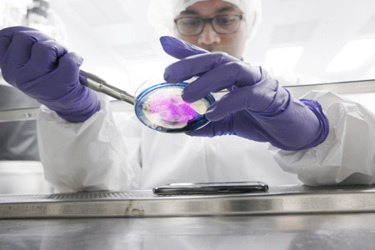A Brief Introduction To Environmental Monitoring For Startups
By Aashi Mishra, Research Nester

Environmental monitoring is a crucial part of any pharmaceutical, biotechnologically manufactured, or medical device-operated process to indicate that the microbial particulate content of all cleanroom air and work surfaces is below acceptable levels. It’s also a regulatory necessity.
Acceptable microbial concentrations in a given system can vary from less than 10 colony-forming units per milliliter (CFU/ml) to as much as 10^4 CFU/ml, which is the same as 10,000 bacteria per milligram of water. Moreover, when a stable system has less than 10^3 CFU/ml, it is considered to be in control; when it has 10^5 CFU/ml or more, it is considered to be out of control and requires an antimicrobial solution.
The data are derived from samples of air, surfaces, and personnel in a clean environment. The development of both sterile (such as injections, infusions, ophthalmic solutions) and non-sterile (such as solutions, capsules, tablets, and ointments) pharmaceutical goods depends heavily on environmental monitoring.
Microbially contaminated drugs or devices can cause infections in the patients receiving them, potentially leading to immediate or long-term damage. These microbes alter drugs' chemical and pharmacological properties and impact the product’s effectiveness. So, environmental monitoring is necessary to keep any biomanufacturing process pure and functional.
The 3 Areas Of Environmental Monitoring Evaluation
Environmental monitoring evaluates the quality of surfaces, air, and personnel through sample testing and quality assurance checks.
- Surface monitoring: Even when a lab or cleanroom has been completely cleaned, bacteria can spread fast from one surface to another by touching a surface with contaminated equipment. To test for germs, an agar plate is directly placed on a surface to be tested, then it is covered and incubated. To further disinfect the surface, staff should spray it down with isopropyl alcohol.
- Air monitoring: Any lab or production environment must have good air quality because airborne microorganisms raise the possibility of cross-contamination between components and finished goods. The CDC lists bacteria, fungi, viruses, and pollen as examples of biological air pollutants. Air samples are collected using active air samplers or laser particle counters. Microorganisms are detected by incubating and analyzing these samples. An identification test can pinpoint the source of the microbe if there is microbial contamination in the air.
- Personnel monitoring: Two simple methods for performing personnel testing are direct fingertip contact with a tryptic soy agar (TSA) plate and swabbing the forehead or elbows with a cotton swab dipped in tryptic soy broth (TSB). Then, plates are covered and incubated for around 18 hours before being checked for the presence of bacteria.
The 4 Types Of Environmental Monitoring
The environmental monitoring market is categorized based on type of monitoring equipment, media, software, and microbiology services.
- Monitoring Equipment: Environmental monitoring data tracked via monitoring equipment include airflow analysis, particle counters for air pollution, and temperature, humidity, and pressure measures, among others. Monitoring equipment also can be categorized as microbiology instruments, which include test devices for mycoplasma detection, endotoxin testing (LAL assay), and bioburden testing (Bacillus count). Particle counting instruments, such as photometer-based contaminant detectors and laser scattering detectors, etc., are also used.
- Media: Nutrients for laboratory growth are used to prepare media for use in microorganism research. By using media, microbial contamination can be found and isolated. It can then be further examined to see if there is a risk to patient safety. Media can be found in either a solid or liquid state.
- Software: Real-time monitoring software allows for the continuous monitoring of environmental conditions in pharmaceutical and biotechnological facilities. This software can be used to monitor factors like temperature, humidity, and other elements that impact the quality and safety of products. Software analysis can identify patterns and trends, and can even make predictions about future environmental conditions.
- Microbiology Services: Independent testing laboratories provide microbiology services. Before being put on the market, medicines, biologics, and medical devices are subjected to microbiological testing to make sure they are safe for the intended use. Tests include detection of mycoplasma, bioburden, and endotoxin (LAL assay).
In the coming years, our research projects that life sciences companies will use monitoring equipment more than the other three segments (with the most revenue share of 30%).
Key Players In The Market
Some of the companies in this domain are:
- Thermo Fisher Scientific Inc.
- Danaher Corporation
- QIAGEN
- Agilent Technologies, Inc.
In the years to come, the pharmaceutical and biotechnology environmental monitoring sector is expected to grow significantly owing to the growing adoption of such practices in small and medium enterprises. For service providers in the space, the pharmaceutical and biotechnology environment monitoring industry was valued at around $978 million in 2022. The market is expected to reach $1.39 billion by the end of 2035, increasing at a compound annual growth rate (CAGR) of 6.5% over the projected period.
Recent Innovations
- One of the recent advances in cleanroom monitoring is continuous particle counting and measurement, to detect contaminants such as volatile organic compounds (VOCs), becoming the norm.
- Potential tools for the quick, accurate, and extremely sensitive detection of the target analyte (including biotic and abiotic pollutants) are nanoparticle-based biosensors. The main strategy is to improve output by using nanoparticles as signal reporters rather than spending time increasing cell concentrations. We will also see trends in the creation of novel detection technologies, as well as their advantages over existing environmental monitoring techniques.
Pharmaceutical and biotechnology environmental monitoring is not just a regulatory necessity; it’s a critical element of responsible and sustainable industry practices. As these sectors continue to grow and innovate, the commitment to monitoring, compliance, and innovative technologies is essential.
 About The Author:
About The Author:
Aashi Mishra is a content developer at Research Nester and is also an electronics engineer. She has three years of market research experience.
